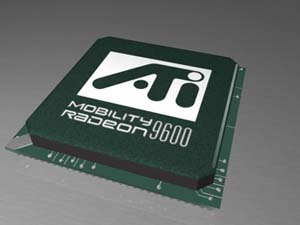The Future of Mobile Gaming: New Chips from ATI and NVIDIA
by Matthew Witheiler on March 13, 2003 8:59 AM EST- Posted in
- Laptops
ATI - Mobility Radeon 9600 and Mobility Radeon 9600 Pro
The final products that ATI is talking about today are the Mobility Radeon 9600 and Mobility Radeon 9600 Pro, two high-end DX9 mobile parts. The two Mobility Radeon 9600 solutions are mobile versions of the desktop Radeon 9600 (RV350). Because of this, we will not be going into detail on the hardware behind the Mobility Radeon 9600. Instead you should read up on the chip here. Briefly, a few important things to remember about the Radeon 9600 (and thus the Mobility Radeon 9600 chips) are the facts that it is produced on a 0.13 micron process, incorporates some serious memory controller optimizations over the RV300 (Radeon 9500) that it replaces, and has a new version of Hyper-Z compression technology.

Both Mobility Radeon 9600s incorporatePOWERPLAY technology and are well gated to allow portions of the chip to remain unpowered while not in use. ATI's technical details indicate that the chips actually consumes only 0.5W while in Windows idle. No information on the maximum power consumption of the chip were given.
Being based on the R300 graphics core does have its advantages. Thanks to the base that the R300 set up for the RV350 core, the Mobility Radeon 9600 chips have a number of advanced features. For example, the Mobility Radeon 9600 chips offer component output support. This is a nice addition for those driving HDTVs or high quality projectors with their notebook during presentations. Also present is video-input support and MPEG-2 hardware encode acceleration which we investigated in our All-in-Wonder 9700 Pro review.
The process shrink that the Mobility Radeon 9600 underwent helps keep power consumption of the chip low. Compared with the Mobility Radeon 9000, the Mobility Radeon 9600 consumes the same amount of power and actually runs at 0.5V less (the chip runs at 1.0V). This is done even with the high 350MHz core clock speed and 300MHz DDR memory clock (600MHz effective) speed that the chip is clocked at. The clock speeds of the Mobility Radeon 9600 place the chip between the desktop Radeon 9600 Pro's 400/300MHz DDR speed and the desktop Radeon 9600's 325/200MHz DDR speed. The chip should be one fast mobile graphics processor.
The Mobility Radeon 9600 Pro one ups the base Mobility Radeon 9600 by offering higher core clock speeds and GDDR2-M memory support for higher memory clock speeds. Contrary to what its name may suggest, GDDR2-M memory is not DDR2 memory. Like the "DDR2" memory used by the GeForce FX, the GDDR2-M memory that the Mobility Radeon 9600 Pro supports does not transmit four times per clock. Instead the memory is optimized and therefore able to run at higher frequencies than before.
The GDDR2-M memory support that the Mobility Radeon 9600 Pro offers allows the memory chips used on the processor to operate somewhere between "DDR600 and DDR900 or above" speeds, indicating that 900+MHz effective operating frequencies are possible. Just how fast the memory will go ATI is not yet saying, probably due to the fact that GDDR2-M memory is not readily available or in mass production quite yet. As a side note, the GDDR2-M memory offers power saving features over both GDDR-2 and regular DDR memory chips and does not require external termination (saving precious space).
Another feature that the Mobility Radeon 9600 Pro offers is what ATI calls OVERDRIVE. OVERDRIVE is an automatic overclocking utility that is available for use in the drivers. The utility makes use of an on chip thermal diode to monitor temperature and overclock until a specific temperature or clock speed limit is reached. The OVERDRIVE feature is interesting on paper but we will have to wait until we get our hands on a notebook using the Mobility Radeon 9600 Pro before we can judge its effectiveness. It does sound like a good solution for desktop replacement and high performance gaming notebooks but will undoubtedly effect battery life while enabled.
The Mobility Radeon 9600 is available in four configurations: a discrete package, a 32MB integrated memory package, a 64MB integrated memory package, and a 128MB integrated package. The Mobility Radeon 9600 is the first mobile chip to be offered with 128MB of on package. We noticed the move in graphics memory from 64MB to 128MB on the desktop side about five months ago and the notebook market seems to be quickly following. As the IBM T40p notebook examined in our Centrino/Pentium M roundup reveals, people out there are using memory on package solutions to bring mobile 3D to new places.
Details on the package solutions available for the Mobility Radeon 9600 Pro were not available but we suspect that the chip will begin production in a discrete only design.











0 Comments
View All Comments